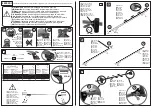
6
LLuubbrriiccaannttss
1. Ikelite provides silicone lubricant with the housing. We recommend
you use only Ikelite lubricant on Ikelite products as some other
brands may cause the o’ring to swell and not seal properly.
2. Use only enough lubricant to lightly cover control shafts and
o’rings. Wipe off any excess lubricant with a clean cloth.
Lubricant is not a sealant, it is used to reduce friction. Excessive
lubricant can collect sand and dirt which may interfere with
proper sealing.
CCAAU
UTTIIO
ON
N
N
Neevveerr uussee sspprraayy lluubbrriiccaannttss aass tthhee pprrooppeellllaanntt iinnggrreeddiieenntt ccaann
ccaauussee tthhee ppllaassttiicc hhoouussiinngg ttoo ccrraacckk..
CChheecckkiinngg CCoonnttrroollss
Once the housing has been closed, push the controls back into
place. Make sure they line up with the camera’s controls.
TTuurrnn CCaam
meerraa O
Onn
Turn the camera on and operate each of the housing controls to
get a feel for using the camera in the housing. Take a few
pictures above water with the camera in the housing.
ZZoooom
m CCoonnttrrooll
(NOTE:) After you have used the
housing’s zoom control it must be
returned to the center position to
disengage. If the housing zoom
control is pushing the zoom lever
in either direction the camera
may not take a picture or access
any other function as the camera
is receiving a signal from the
engaged zoom control.
+
-
+
-
Zoom control
engaged
Zoom control
disengaged
(centered)
5
CClloossiinngg tthhee H
Hoouussiinngg
1. Place housing face down in your
lap or on a flat surface.
2. Check to see that there is an
o’ring on the housing back and
that it is clean and in its proper
location.
3. Guide the back onto the housing.
The o’ring should touch the
housing all the way around. There
should be an even gap all the way
around between the housing and
the housing back.
4. Lift the lid snaps so they are
extended and place the lid snap
into the hook on the housing
back.
5. To close the housing push
down on the lid snaps until
they snap into place . Lid
snaps on opposite sides of the
housing should be closed at the
same time. Be sure they are down
far enough to engage the lock.
D
Doouubbllee cchheecckk - Once the housing is closed, check the o’ring seal.
Check the gap between the housing back and the housing, it
should be even all the way around.
Look through the clear plastic back at the o’ring. You should see a
darkened area where the o’ring is compressed against the
housing back. If you do not see an even black compression seal
all the way around the back, open the lid snaps, reseat the
housing back and close the lid snaps. Visually check the seal again.
o’ring
housing back
housing back
housing
housing
o’ring
even gap
all 4 sides
7
LLeennss PPoorrtt
The Lens Port is factory sealed, do not remove.
Treat the glass in the lens port as a camera lens. After use, rinse
and gently dry the lens port to avoid water spotting. To clean
use a mild soap solution or lens cleaner.
Do not use alcohol or window cleaner on the Lens Port.
The Lens Port is threaded so that accessory lenses can be
screwed onto the port. The threads are very fine, take care not
to cross thread the lens.
Wide angle lenses are available from Inon, Sea & Sea and
Epoque. These lenses can be screwed onto the lens port above
or below water. These lenses are designed to have water
between the front of the port and the accessory lens. Make sure
no air bubbles are trapped between the port and the accessory
lens. There may be slight vignetting when these wide angle
lenses are installed. Any vignetting that occurs can be
eliminated by zooming the camera lens slightly. To properly
light subjects when using
a wide angle lens an
external strobe should be
used. Due to the wide
angle of coverage of the
Inon,Sea & Sea and
Epoque lenses, the DS125
Substrobe is
recommended or two
DS51 Substrobes.
Wide Angle Lens
Housing shown with
accessory wide angle lens.
4
O
Oppeenniinngg tthhee H
Hoouussiinngg
1. Lid Snaps have a LLoocckk.
To open, push Lid Snap Lock
forward and lift as shown.
Keep pressure on the Lid
Snap so it does not fly open
quickly.
Some lid snaps have a lot of
spring tension once they go over center, have a firm grip on the
lid snap. Lid Snaps may be opened one at a time.
IInnssttaalllliinngg tthhee CCaam
meerraa
1. Remove the back from
the housing. The
mounting tray for the
camera is secured to
the housing back.
Position the camera on
the tray and secure it
with the mounting bolt
which threads into the
camera’s tripod socket.
U
Ussee aa ccooiinn oorr ffllaatt
bbllaaddddeedd ssccrreew
wddrriivveerr ttoo
ttiigghhtteenn tthhee m
moouunnttiinngg
bboolltt ssoo tthhee ccaam
meerraa iiss
ffllaatt aaggaaiinnsstt tthhee ttrraayy..
CCAAU
UTTIIO
ON
N::
Some camera tripod socket threads are plastic. The mounting
tray bolt is metal. Do not cross thread or over tighten as you
may damage the camera tripod socket threads.
2. Pull out on each housing control until it stops. This will get the
controls out of the way for installing the camera.
Lift
Push Forward
Lid Snap Lock
Lid Snap Lock
Push Forward
Lift
Lid
Hook
O' Ring
Housing Back
Mounting
Bolt
Mounting
Tray
























